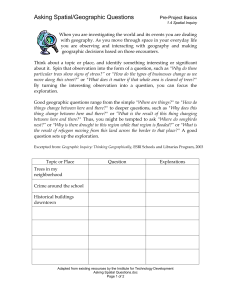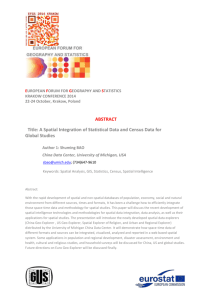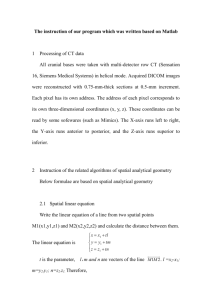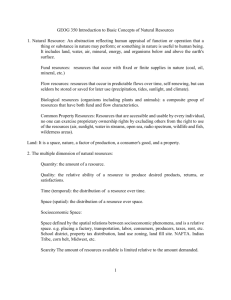Spatial Behavior: A geographic perspective on travel behavior and
advertisement
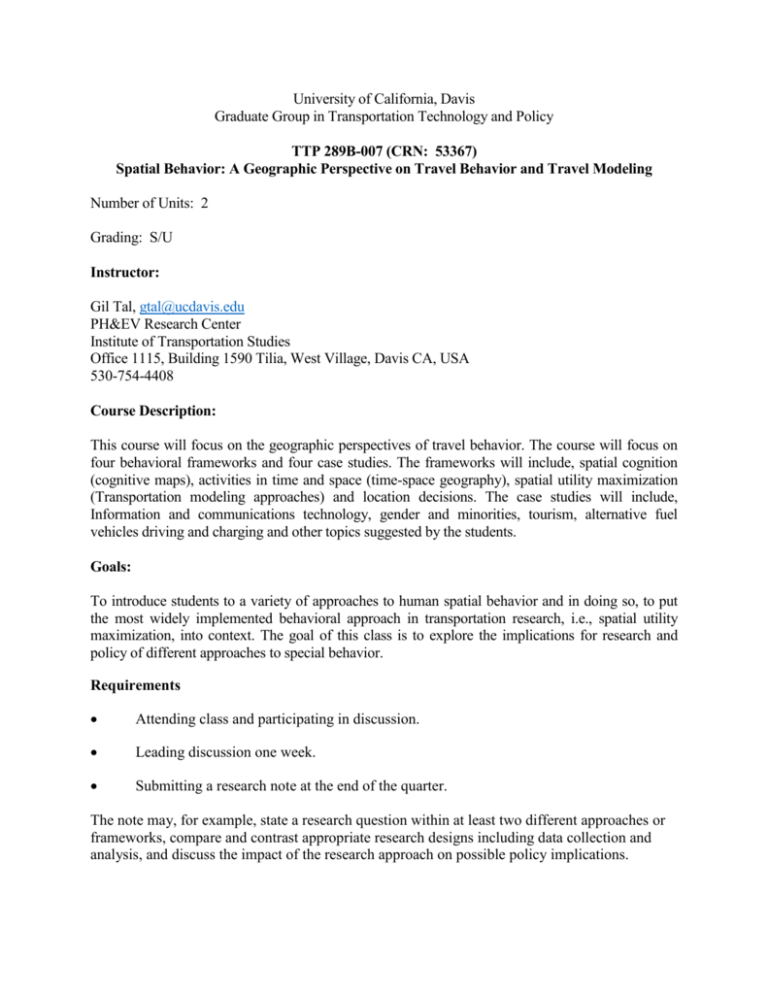
University of California, Davis Graduate Group in Transportation Technology and Policy TTP 289B-007 (CRN: 53367) Spatial Behavior: A Geographic Perspective on Travel Behavior and Travel Modeling Number of Units: 2 Grading: S/U Instructor: Gil Tal, gtal@ucdavis.edu PH&EV Research Center Institute of Transportation Studies Office 1115, Building 1590 Tilia, West Village, Davis CA, USA 530-754-4408 Course Description: This course will focus on the geographic perspectives of travel behavior. The course will focus on four behavioral frameworks and four case studies. The frameworks will include, spatial cognition (cognitive maps), activities in time and space (time-space geography), spatial utility maximization (Transportation modeling approaches) and location decisions. The case studies will include, Information and communications technology, gender and minorities, tourism, alternative fuel vehicles driving and charging and other topics suggested by the students. Goals: To introduce students to a variety of approaches to human spatial behavior and in doing so, to put the most widely implemented behavioral approach in transportation research, i.e., spatial utility maximization, into context. The goal of this class is to explore the implications for research and policy of different approaches to special behavior. Requirements Attending class and participating in discussion. Leading discussion one week. Submitting a research note at the end of the quarter. The note may, for example, state a research question within at least two different approaches or frameworks, compare and contrast appropriate research designs including data collection and analysis, and discuss the impact of the research approach on possible policy implications. Readings Circella, G., Mokhtarian, P. L., & Poff, L. K. (2012). A conceptual typology of multitasking behavior and polychronicity preferences. electronic International Journal of Time Use Research (eIJTUR), 9(1), 59-107. Golledge, R. G. (1997). Spatial behavior: A geographic perspective. Guilford Press. Golledge, R. G., & Garling, T. (2001). Spatial behavior in transportation modeling and planning. University of California Transportation Center. http://www.uctc.net/papers/602.pdf Hannes, E., Janssens, D., & Wets, G. (2008). Destination choice in daily activity travel: mental map's repertoire. Transportation Research Record: Journal of the Transportation Research Board, 2054(1), 20-27 Joachim Scheiner, (2014), The gendered complexity of daily life: Effects of life-course events on changes in activity entropy and tour complexity over time, Travel Behaviour and Society, Volume 1, Issue 3, September 2014, Pages 91-105 Levinson, D. M., & Kumar, A. (1994). The rational locator: why travel times have remained stable. Journal of the American Planning Association, 60(3), 319-332. Mokhtarian, P. (2009). If telecommunication is such a good substitute for travel, why does congestion continue to get worse? Transportation Letters, 1(1), 1-17. Mokhtarian, P. L. (2005). Travel as a desired end, not just a means. Transportation Research Part A: Policy and Practice, 39(2), 93-96. Mondschein, A., Blumenberg, E., & Taylor, B. (2010). Accessibility and cognition: the effect of transport mode on spatial knowledge. Urban studies,47(4), 845-866.



